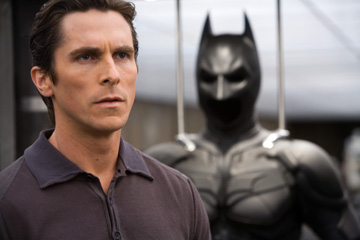
Christopher and Johnathan Nolan, as very established auteurs, have many strong points and few weak ones. Easily my favorite aspect of their filmmaking is that they never treat the audience as stupid. Every scene in “The Dark Knight” is full of plot-centric dialogue that whizzes by at a Flash’s pace, and never pauses to take a breath. The net effect is facilitated by the fact that the audience never feels that the Nolans are trying to outpace them (as some all-too-clever action plots tend to do), and the result is that the pacing keeps up a “not too fast, not too slow” metronome that keeps the audience infinitely glued to their seats. This, and many other qualities, outshine the few weak points in their work, such as a tendency for some characters to be over-philosophical and self-aware, which occasionally distracts from the fantasy.
Taken as a whole, “The Dark Knight” is a thrill ride and philosophical exercise wrapped in a batbox, a celebration for a monumental character in popular Americana that has been long overdue. Indeed, Christopher Nolan’s direction and Johnathan Nolan’s screenplay are helped by the very enthusiastic performances of Christian Bale (Batman) and Aaron Eckhart (Harvey Dent), not to mention the out-of-this-world extravaganza produced by Heath Ledger’s take on the Joker. Like in “Batman Begins,” the supporting character roles are given to an A-list supporting squad, which back the emotional heart of the story up with serious aplomb.
The many strengths of the filmmaking greatly overshadow the few flaws in the overall production, but the flaws are certainly still there. Though I will always have a sentimental spot in my heart for the more fantasy-inspired versions of Batman (perhaps a topic for a later column), I do not count the all-too-realistic account of a fantasy character to be a flaw in the production. Instead, in the intention of being a balanced critic, I will have to resort to nitpicking to find the major weaknesses of the work. These include, but are not limited to, the serious uber-planning required for the Joker’s schemes (seriously, how do they seem to work down to the last inch?), the bloated feeling of Act Three addendum to the addition of Two-Face, the superfluous and relatively unnecessary Hong Kong scene, and the fact that Christian Bale’s Batman voice sounds less the menacing superhero and more like the Batman has a rather severe cold. These problems, while slightly distracting and questionable, are overpowered by the tremendous quality of the rest of the work.

Christopher Nolan’s “Dark Knight” bears little resemblance to any previous “Batman” franchise, and in an almost perfect blend of auteur and franchise filmmaking, combines his own postmodern and almost self-aware cinematic techniques with the touchstones of the Batman franchise to make a film that practically writes the book on adapting comics to film. While it may seem obvious to say that Nolan’s Batman differs from the old Adam West hoary hoedowns of the 1960s (holy alliteration Batman!) in its gritty realism, what will shock some young or casual moviegoers is that this Batman is far more realist than even the gritty Batman comics and animated television show of the early 1990s. Even those Batmans had Batplanes and Mr. Freeze and the Joker’s signature laughing gas, while this new Batman ignores even those fantastical elements to present, presumably, a more “down-to-earth” realism feeling.
“The Dark Knight’s” plot, on the surface at least, feels simple. By the beginning of the film, Batman and police Lieutenant Gordon have all but rounded up the entire Gotham mob and have been preparing a trail of marked bills to catch the remains of the city’s criminal elite. The mob, in defense, decides to go corporate, and starts dealing with a wealthy Hong Kong businessman who can launder their money in and out of the country, free from police interference. Into this setting enters two opposing wild cards: new district attorney Harvey Dent, determined to stop organized crime once and for all in Gotham City, and The Joker, an eccentric thief who has been stealing millions of dollars from mob-controlled banks for no particular reason. Harvey quickly becomes a leader in Batman’s camp, The Joker is hired by the mob to try to stop Dent and the Batman, and away we go. That, in all honesty, is the plot: these two sides battle for control of the city. Of course, the genius points in Nolan’s film reside in the complicated subtleties and subplots, the super-fast pacing, and the symbolic motifs found throughout. Like all astute filmmakers, Christopher Nolan knows that it’s not what the action is that matters; it’s how it unfolds that creates the art. And the art in “The Dark Knight,” most definitively, is the character development through these subplots.
In the next installment, we will further discuss the implications of the individual characters as they relate to the plot of the movie.
No comments:
Post a Comment